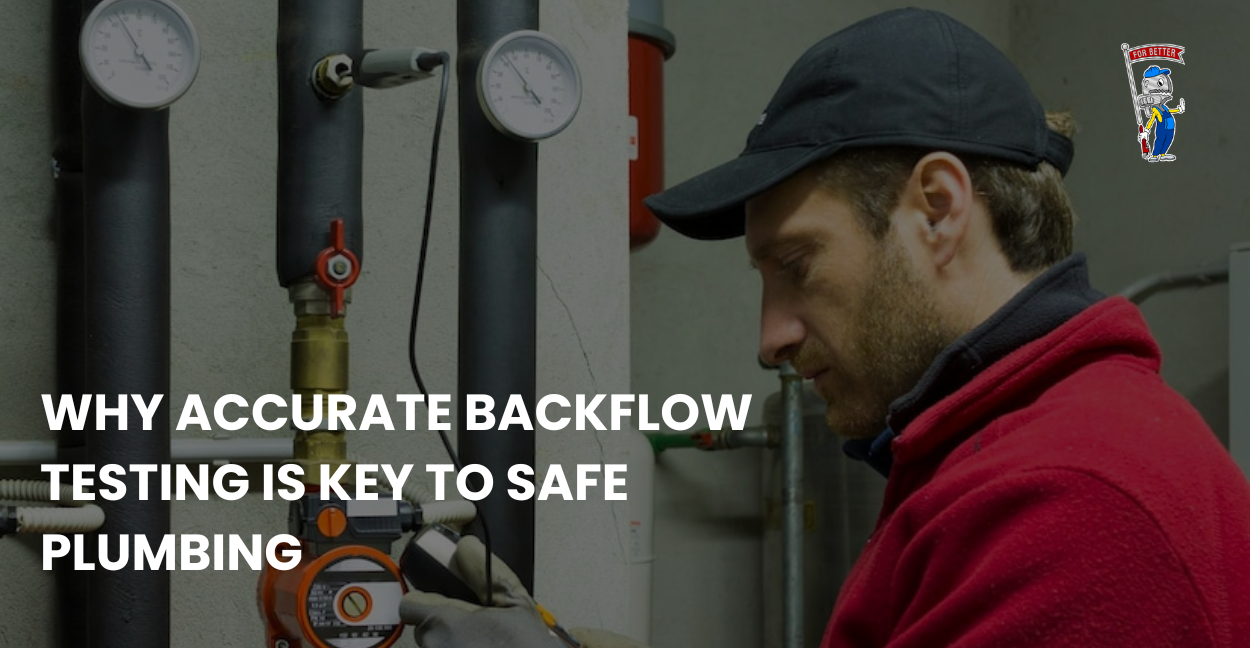Backflow testing is an essential part of maintaining a healthy and safe plumbing system. It helps detect any potential risks before they escalate, ensuring that harmful substances, such as bacteria, chemicals, or sewage, do not contaminate your drinking water. By identifying and addressing backflow issues early, you can avoid costly repairs and prevent the spread of waterborne illnesses. Regular and accurate backflow testing not only safeguards your health but also extends the lifespan of your plumbing system. In this article, we will delve into the importance of backflow testing, how it works, and what steps you can take to ensure your plumbing remains in optimal condition.
What is Backflow and Why is It Dangerous?
Backflow can happen for various reasons, such as a sudden drop in water pressure due to a burst pipe, a malfunctioning water pump, or even a backflow preventer that isn’t working properly. When this reversal occurs, hazardous substances like pesticides, chemicals, sewage, or even dirty water from toilets can enter your clean water supply. This poses a significant risk to the health of everyone who uses that water. Without proper backflow prevention and regular testing, your plumbing system becomes vulnerable to these dangerous contaminants, making it essential to address backflow issues promptly. By ensuring that your backflow prevention devices are functioning correctly, you can protect both your health and your plumbing system.
How Backflow Testing Helps Prevent Contamination
During a backflow test, a certified professional will inspect the backflow prevention devices to ensure they are properly sealed and functioning as intended. If any issues are detected, such as a malfunctioning valve or a damaged air gap, repairs or replacements can be made immediately to prevent contamination. Regular testing also helps identify any potential vulnerabilities in the plumbing system before they become major problems. This proactive approach not only protects your health but also ensures that your plumbing system remains in good working condition, reducing the risk of costly repairs down the line. By staying on top of backflow testing, you can enjoy peace of mind knowing that your water supply is safe and secure.
The Critical Role of Accurate Backflow Testing in Plumbing Safety
Accurate backflow testing is a cornerstone of maintaining a safe and efficient plumbing system. Here’s why it is essential:
-
Prevents Contamination
Backflow testing protects the clean water supply from contamination caused by chemicals, pesticides, bacteria, and other pollutants. These contaminants can infiltrate the water system through industrial processes, lawn fertilizers, or wastewater, making it unsafe for drinking or bathing. Regular testing ensures backflow prevention devices, like check valves and air gaps, are functioning properly to safeguard your household and community.
-
Complies with Regulations
Strict regulations require regular backflow testing to protect public health and water systems. Annual or biannual testing by certified professionals is often mandated to ensure compliance. Failing to comply can lead to fines, penalties, or service interruptions. Accurate testing ensures adherence to these regulations, avoiding unnecessary expenses and disruptions.
-
Protects Public Health
Backflow contamination can affect entire communities, especially in high-risk areas like hospitals, schools, or industrial facilities. Contaminants such as E. coli and lead can cause outbreaks of illnesses and infections. Accurate backflow testing helps prevent these risks, ensuring clean and safe water for everyone in the community.
-
Maintains Water Pressure
Proper water pressure is essential for a smoothly operating plumbing system. Low pressure can lead to backflow and contamination, while high pressure can damage pipes and devices. Regular testing identifies and resolves pressure issues, extending the lifespan of your plumbing system and improving appliance efficiency.
-
Prevents Costly Repairs and Liabilities
Unchecked backflow can cause severe damage to your plumbing system, leading to expensive repairs. Contaminated water can corrode pipes, damage fixtures, and reduce appliance efficiency. Regular testing helps identify issues early, preventing costly repairs and potential legal liabilities if your property causes contamination.
-
Supports Environmental Protection
Backflow contamination can harm the environment by introducing pollutants into rivers, lakes, and other water bodies. This endangers aquatic life and ecosystems. Accurate backflow testing prevents these pollutants from entering the water supply, helping to protect natural resources and promote sustainability.
How Often Should Backflow Testing Be Performed?
Backflow testing should be performed annually to ensure that your plumbing system is functioning correctly and to identify potential issues early. In some areas, local regulations may require more frequent testing, especially for commercial properties or homes with irrigation systems, as these are more prone to backflow risks. It is essential to follow these guidelines to ensure compliance with local laws and protect your water supply from contamination.
Essential Backflow Prevention Devices for a Safe Plumbing System.
Backflow prevention devices are essential components of a safe plumbing system, designed to prevent contaminated water from reversing into the clean water supply. Here are some of the most commonly used devices and how they work:
-
Check Valves
Check valves are one-way valves that allow water to flow in only one direction. They are simple yet highly effective in preventing backflow when water pressure drops. Commonly used in residential and commercial plumbing systems, these devices automatically close if water starts to flow in the reverse direction, ensuring that contaminants cannot enter the clean water supply. Check valves are often installed in irrigation systems, boiler feeds, and other applications where backflow risks are present.
-
Air Gaps
An air gap is a physical, open space between the water supply outlet and the flood level of a fixture or container. For example, the space between a faucet and the rim of a sink serves as an air gap. This separation ensures that contaminated water cannot siphon back into the clean water supply, even if there is a drop in water pressure. Air gaps are a simple, reliable, and maintenance-free method of backflow prevention, commonly used in dishwashers, washing machines, and water softeners.
-
Pressure Vacuum Breakers (PVBs)
Pressure vacuum breakers are mechanical devices used primarily in irrigation systems and outdoor plumbing setups. They prevent backflow by introducing air into the system when a sudden drop in pressure occurs. PVBs consist of a check valve and an air inlet valve, which work together to stop the reversal of water flow. These devices are cost-effective, easy to install, and an essential safeguard for garden hoses, sprinkler systems, and other outdoor water connections.
-
Reduced Pressure Zone (RPZ) Assemblies
RPZ assemblies are advanced backflow prevention devices designed for high-risk applications, such as industrial facilities, hospitals, and large commercial buildings. They feature two check valves with a pressure relief valve in between, providing a fail-safe mechanism to prevent backflow. If one check valve fails, the pressure relief valve opens to discharge contaminated water, ensuring it doesn’t enter the clean water supply. RPZ assemblies are highly effective and often required by law in critical settings.
-
Double Check Valve Assemblies
Double check valve assemblies consist of two independent check valves within a single unit, providing an added layer of protection against backflow. These devices are commonly used in fire sprinkler systems, water mains, and medium-risk plumbing applications. Their compact design makes them suitable for installations where space is limited, and they are easier to maintain compared to more complex devices like RPZ assemblies.
-
Atmospheric Vacuum Breakers (AVBs)
Atmospheric vacuum breakers are another type of backflow prevention device often used in irrigation systems. These devices consist of a valve that opens to allow air into the system when water pressure drops, preventing contaminated water from being siphoned back into the clean supply. AVBs are simple, cost-effective, and ideal for low-risk applications, though they require careful installation and maintenance to function correctly.
How to Ensure Accurate Backflow Testing
Accurate backflow testing is crucial to maintaining the safety and efficiency of your plumbing system. To achieve this, it is essential to rely on a certified professional with expertise in backflow prevention. These experts possess the tools, training, and knowledge required to conduct thorough inspections and tests, ensuring your backflow prevention devices are functioning correctly and your water supply remains uncontaminated.
Steps for Ensuring Accurate Backflow Testing
-
Hire a Certified Professional
Begin by hiring a licensed plumber or backflow prevention specialist. Certified professionals are trained to handle backflow prevention devices and comply with local regulations. They understand the complexities of plumbing systems and are equipped to identify potential issues that untrained individuals might overlook.
-
Inspect the Backflow Prevention Devices
The first step in the testing process is a visual inspection of the backflow prevention devices, such as check valves, air gaps, or pressure vacuum breakers. The plumber will assess the condition of the devices, looking for signs of wear, corrosion, or damage. This step ensures the devices are in good working order and ready for testing.
-
Test the Water Pressure
Maintaining the correct water pressure is critical for preventing backflow. The professional will measure the water pressure in your plumbing system using specialized tools. If the pressure is too low or too high, it can compromise the effectiveness of the backflow prevention devices. Adjustments to the system may be recommended to ensure optimal performance.
-
Perform the Backflow Test
The plumber will use specialized testing equipment to simulate backflow conditions and assess the functionality of the prevention devices. This process involves introducing controlled pressure changes in the system to ensure the devices respond correctly. Any issues, such as a malfunctioning check valve or a compromised seal, will be identified during this step.
-
Provide a Detailed Report
After completing the test, the professional will provide a comprehensive report. This document will outline the results of the test, including any detected issues and recommendations for repairs or maintenance. The report is also essential for compliance with local regulations, as many municipalities require proof of backflow testing for residential and commercial properties.
-
Schedule Regular Testing
To maintain the effectiveness of your backflow prevention devices, it’s essential to schedule regular testing. Most areas require annual testing, but high-risk properties, such as those with irrigation systems or chemical connections, may need more frequent checks. Work with your plumber to establish a testing schedule that meets local requirements and ensures ongoing safety.
Don’t risk contamination in your water supply! Let Backflow Services Done Right provide accurate and reliable backflow testing. Contact us now to schedule your service and keep your plumbing system in top condition.
FAQs About Backflow Testing
1.) What is backflow, and why is it dangerous?
Backflow is the unwanted reversal of water flow in your plumbing system, which can lead to contaminated water entering your clean water supply. It poses serious health risks, as harmful substances like chemicals, bacteria, and other pollutants can be introduced into the water, making it unsafe for consumption.
2.) How often should backflow testing be performed?
Backflow testing should be performed annually to ensure that your plumbing system is functioning properly. However, some local regulations or specific systems (like irrigation or industrial connections) may require more frequent testing. Always follow local codes and consult with a professional to determine the appropriate testing schedule.
3.) What are the common backflow prevention devices?
Common backflow prevention devices include check valves, air gaps, and pressure vacuum breakers. These devices prevent the reverse flow of contaminated water into the clean water supply by maintaining proper water pressure and creating physical barriers to backflow.
4.) Can I perform backflow testing myself?
Backflow testing requires specialized tools and knowledge of plumbing systems. It is not recommended to perform the test yourself, as incorrect testing can lead to inaccurate results or overlooked issues. It is essential to hire a certified professional plumber to ensure the test is done correctly and in compliance with local regulations.
5.) What happens if my backflow test fails?
If your backflow test fails, it means that one or more of your backflow prevention devices are not functioning properly. A certified plumber will provide a detailed report and recommend repairs or replacements. Failing to address the issue could lead to contamination of your water supply, so it’s important to resolve the problem promptly to ensure the safety of your water.



